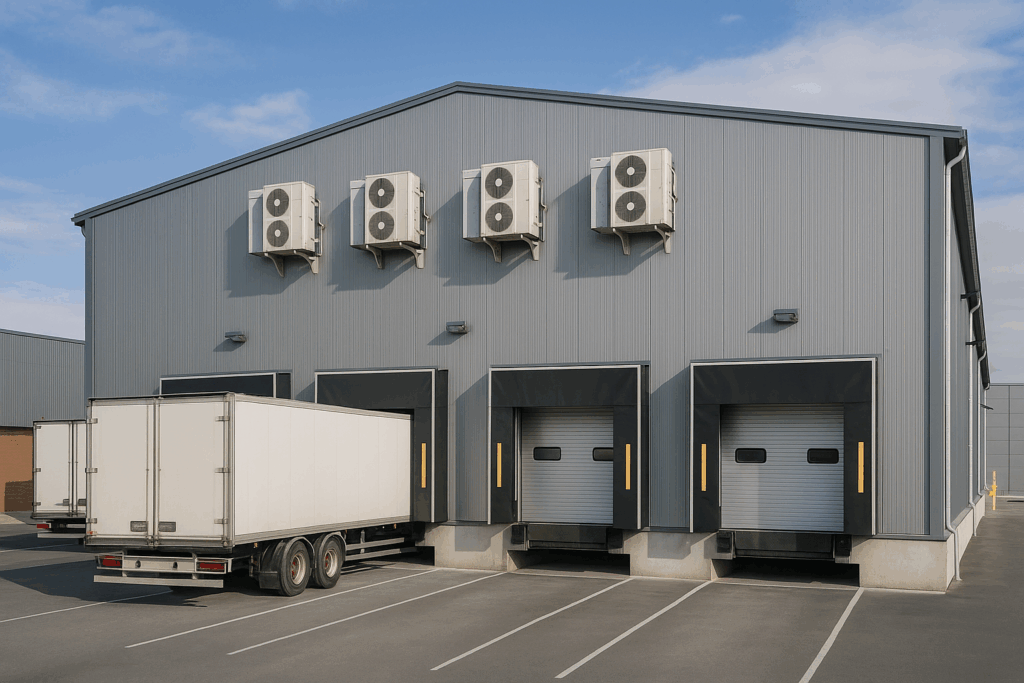Cold storage operations demand more from a building than most commercial facilities. These environments must maintain strict temperature ranges, often between -10°F and 35°F, with minimal fluctuation. A brief deviation can lead to product loss, regulatory violations, or compromised safety. Whether storing frozen foods, pharmaceuticals, or perishable ingredients, the structure itself plays a key role in maintaining product integrity and energy efficiency.
From the outset, design decisions impact everything from operating costs to compliance. With energy making up a significant share of a facility’s expenses, efficient insulation and environmental controls aren’t optional; they’re essential. As demand for temperature-sensitive logistics grows, understanding how facility design supports performance becomes central to staying competitive.
Strong insulation is the backbone of any successful cold storage facility. To hold consistent temperatures without driving up costs, walls and ceilings must meet rigorous thermal performance standards. In freezer zones, that typically means R-values of R-40 or higher in ceilings and at least R-30 in walls. Floors need specialized attention too, with vapor barriers and insulation systems that prevent heat from creeping up through the slab.
Any break in the building envelope (even a small one) can let in warm, humid air. That leads to ice buildup, higher energy use, and problems with temperature consistency. Continuous insulation, air-tight seals, and properly installed vapor barriers help stop thermal bridging and moisture intrusion.
Cold storage panels are often pre-engineered for these challenges. They combine high R-value foam cores with steel skins and integrated vapor barriers. When installed correctly, they reduce temperature drift and protect against long-term damage from condensation or insulation breakdown.

Most cold storage operations include multiple zones with different requirements. Freezers, coolers, and staging areas all need to maintain stable temperatures while minimizing energy waste. Designing these zones with clear separation and efficient airflow can significantly reduce costs and improve reliability.
Balanced air movement prevents temperature layering and hot spots, while reducing the speed of sublimation in frozen goods. Overcooling not only wastes energy, it can also harm certain products. Air handling systems must deliver steady circulation without causing unnecessary evaporation or product degradation.
Ventilation and defrosting systems are also important. Defrost cycles should be timed to avoid operational disruptions, and refrigeration loads must be sized to handle regular activity, not just the theoretical minimum. Doors opening frequently, high throughput, and outside conditions all affect cooling demand.
Cold storage facilities support more than low temperatures… they carry heavy loads. Pallets of frozen goods often require dense racking systems and equipment that exerts substantial force on floors and walls. Facilities need to be engineered accordingly.
That includes reinforced concrete slabs, wall systems designed to support racking attachments, and steel framing that allows for high ceilings. Clear heights of 28 to 32 feet are common in modern facilities, enabling more efficient use of vertical space and automation. Wide, open spans also reduce forklift traffic congestion and improve layout flexibility.
Floors must be sloped and drained properly to handle moisture during defrost cycles. They also need to stand up to thermal cycling and the chemical cleaning agents used to maintain food safety standards.
Cold storage is one of the most energy-intensive building types, with refrigeration systems alone often accounting for two-thirds of total usage. Energy-saving design choices have long-term payoffs, both in lower bills and in operational resilience.
Lighting is one of the simplest upgrades. LED fixtures with motion sensors generate less heat and use a fraction of the energy of traditional systems. Fast-closing insulated doors reduce cold air loss during loading. Even well-positioned racking can improve airflow and reduce strain on cooling units.
A tight building envelope makes the biggest difference. That’s why many operators choose pre-engineered commercial metal buildings with thermal features built into the structure. These systems reduce air leakage and support consistent climate control, helping facilities meet both energy goals and product protection standards.
Modern systems like variable-speed compressors and smart controls further boost efficiency. These allow the equipment to adjust based on actual demand, reducing unnecessary power use during slower operational periods.
Facilities that handle food, pharmaceuticals, or medical materials must meet a wide range of safety and reporting standards. That starts with temperature monitoring and alert systems, but also includes backup power, emergency egress, and fire suppression, all of which should be considered in the design phase.
Data logging, real-time alerts, and dual-sensor systems ensure that operators can document compliance and respond quickly to equipment issues. Redundancy is key. When product loss could cost hundreds of thousands of dollars, a well-designed safety net makes all the difference.
Cold zones require fire suppression systems suited for low temperatures. Standard sprinklers may not operate properly at sub-zero levels, so many facilities use alternative agents or dry systems. Exit paths, vestibules, and emergency lighting all need to be designed to function safely in cold conditions, including ice prevention around doors and visibility planning during outages.
For cold storage operations, success depends on far more than having the right refrigeration units. The building itself plays a critical role in maintaining stable temperatures, protecting products, and keeping energy use in check.
From insulation and airflow to structural strength and emergency planning, every detail matters. Facilities that are built to handle these challenges from the start have a better chance of running efficiently, staying compliant, and scaling with demand.
By prioritizing the building envelope and environmental systems early in the process, operators position themselves to deliver reliable, cost-effective performance year after year.